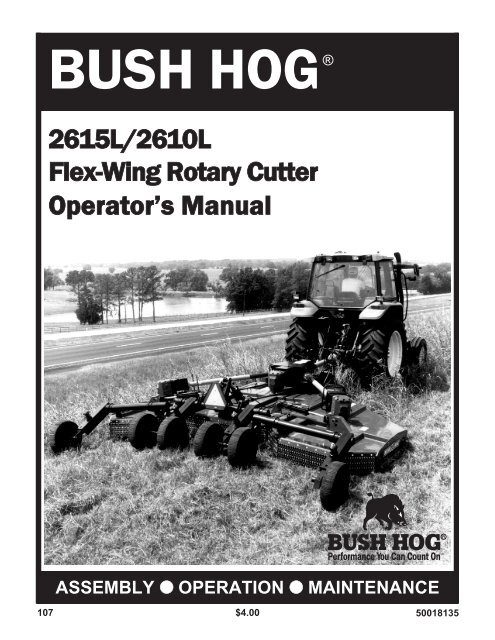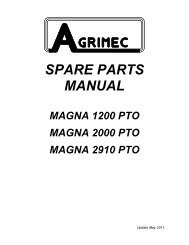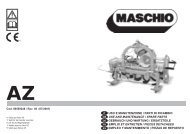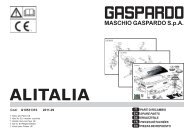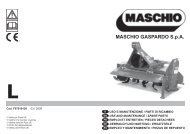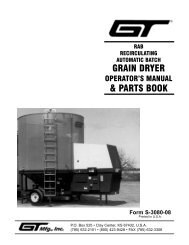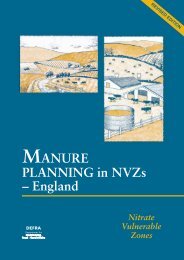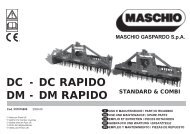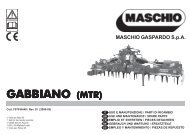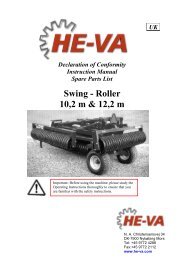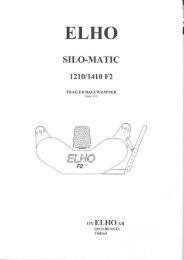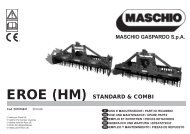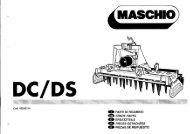You also want an ePaper? Increase the reach of your titles
YUMPU automatically turns print PDFs into web optimized ePapers that Google loves.
BUSH HOG®<br />
<strong>2615</strong>L/2610L<br />
Flex-Wing Rotary Cutter<br />
Operator’s Manual<br />
ASSEMBLY l OPERATION l MAINTENANCE<br />
107 $4.00 50018135
CONGRATULATIONS!<br />
You have invested in the best implement of its type on the market today.<br />
The care you give your Bush Hog implement will greatly determine your satisfaction<br />
with its performance and its service life. We urge a careful study of this <strong>manual</strong> to provide<br />
you with a thorough understanding of your new implement before operating, as well as<br />
suggestions for operation and maintenance.<br />
If your <strong>manual</strong> should become lost or destroyed, Bush Hog will be glad to provide you with<br />
a new copy. Order from Bush Hog, P. O. Box 1039, Selma, Alabama 36702-1039. Most of<br />
our <strong>manual</strong>s can also be downloaded from our website at www.<strong>bushhog</strong>.com.<br />
As an authorized Bush Hog dealer, we stock genuine Bush Hog parts which are<br />
manufactured with the same precision and skill as our original equipment. Our trained<br />
service personnel are well informed on methods required to service Bush Hog equipment,<br />
and are ready and able to help you.<br />
Should you require additional information or assistance, please contact us.<br />
YOUR AUTHORIZED<br />
BUSH HOG DEALER<br />
BECAUSE BUSH HOG MAINTAINS AN ONGOING<br />
PROGRAM OF PRODUCT IMPROVEMENT, WE<br />
RESERVE THE RIGHT TO MAKE IMPROVEMENTS IN<br />
DESIGN OR CHANGES IN SPECIFICATIONS WITH-<br />
OUT INCURRING ANY OBLIGATION TO INSTALL<br />
THEM ON UNITS PREVIOUSLY SOLD.<br />
BECAUSE OF THE POSSIBILITY THAT SOME<br />
PHOTOGRAPHS IN THIS MANUAL WERE TAKEN OF<br />
PROTOTYPE MODELS, PRODUCTION MODELS MAY<br />
VARY IN SOME DETAIL. IN ADDITION, SOME<br />
PHOTOGRAPHS MAY SHOW SHIELDS REMOVED<br />
FOR PURPOSES OF CLARITY. NEVER OPERATE<br />
THIS IMPLEMENT WITHOUT ALL SHIELDS IN PLACE.
<strong>2615</strong>L/2610L ROTARY CUTTER<br />
TABLE OF CONTENTS<br />
SECTION/PARA<br />
PAGE<br />
Warranty ................................................2<br />
Dealer Preparation Check List ...............3<br />
Safety Precautions.................................4<br />
Federal Laws and Regulations ..............5<br />
I. INTRODUCTION & DESCRIPTION ......6<br />
1-1 Introduction ......................................6<br />
1-2 Description.......................................6<br />
II. PREPARATION FOR USE ....................7<br />
2-1 Attaching To Tractor .......................7<br />
2-2 Optional Valve Mounting<br />
Bracket Installation ..........................7<br />
2-3 Pitch Adjustment..............................8<br />
2-4 Wing Adjustment..............................8<br />
III.OPERATING INSTRUCTIONS..............9<br />
3-1 General Safety.................................9<br />
3-2 Transporting.....................................9<br />
3-3 Operation .........................................9<br />
SECTION/PARA<br />
PAGE<br />
IV.MAINTENANCE ..................................10<br />
4-1 Maintenance Check List ................10<br />
4-2 Lubrication .....................................11<br />
4-3 Blade Replacement .......................12<br />
4-4 Slip Clutch Operational Check.......13<br />
4-5 Slip Clutch Adjustment...................13<br />
4-6 Troubleshooting .............................13<br />
V. ASSEMBLY..........................................16<br />
5-1 Model <strong>2615</strong>L Assembly .................16<br />
5-2 Model 2610L Assembly .................20<br />
5-3 Safety Chain Installation ................20<br />
5-4 Band Installation ............................22<br />
5-5 Front Belting ..................................22<br />
Hydraulic Diagrams..............................23<br />
Safety Decals.......................................25<br />
Torque Specifications ..........................27<br />
RETAIL CUSTOMER’S RESPONSIBILITY<br />
UNDER THE BUSH HOG WARRANTY<br />
It is the Retail Customer and/or Operator’s responsibility to read the Operator’s Manual, to<br />
operate, lubricate, maintain and store the product in accordance with all instructions and<br />
safety procedures. Failure of the operator to read the Operator’s Manual is a misuse of this<br />
equipment.<br />
It is the Retail Customer and/or Operator’s responsibility to inspect the product and to have<br />
any part(s) repaired or replaced when continued operation would cause damage or excessive<br />
wear to other parts or cause a safety hazard.<br />
It is the Retail Customer’s responsibility to deliver the product to the authorized Bush Hog<br />
Dealer, from whom he purchased it, for service or replacement of defective parts which are<br />
covered by warranty. Repairs to be submitted for warranty consideration must be made within<br />
forty-five (45) days of failure.<br />
It is the Retail Customer’s responsibility for any cost incurred by the Dealer for traveling to or<br />
hauling of the product for the purpose of performing a warranty obligation or inspection.<br />
1
LIMITED WARRANTY<br />
OOOOOOOOOOOOOOOOOOOOOOOOOOOOOOO<br />
Bush Hog warrants to the original purchaser of any new Bush Hog equipment, purchased from an<br />
authorized Bush Hog dealer, that the equipment be free from defects in material and workmanship for a period<br />
of one (1) year for non-commercial, state and municipalities’ use and ninety (90) days for commercial use from<br />
date of retail sale. Model <strong>2615</strong>L gearboxes are covered by a five (5) year limited warranty period. The obligation<br />
of Bush Hog to the purchaser under this warranty is limited to the repair or replacement of defective parts.<br />
Replacement or repair parts installed in the equipment covered by this limited warranty are warranted<br />
for ninety (90) days from the date of purchase of such part or to the expiration of the applicable new equipment<br />
warranty period, whichever occurs later. Warranted parts shall be provided at no cost to the user at an<br />
authorized Bush Hog dealer during regular working hours. Bush Hog reserves the right to inspect any equipment<br />
or parts which are claimed to have been defective in material or workmanship.<br />
DISCLAIMER OF IMPLIED WARRANTIES & CONSEQUENTIAL DAMAGES<br />
Bush Hog’s obligation under this limited warranty, to the extent allowed by law, is in lieu of all warranties,<br />
implied or expressed, INCLUDING IMPLIED WARRANTIES OF MERCHANTABILITY AND FITNESS<br />
FOR A PARTICULAR PURPOSE and any liability for incidental and consequential damages with respect to<br />
the sale or use of the items warranted. Such incidental and consequential damages shall include but not be<br />
limited to: transportation charges other than normal freight charges; cost of installation other than cost<br />
approved by Bush Hog; duty; taxes; charges for normal service or adjustment; loss of crops or any other loss of<br />
income; rental of substitute equipment, expenses due to loss, damage, detention or delay in the delivery of<br />
equipment or parts resulting from acts beyond the control of Bush Hog.<br />
THIS LIMITED WARRANTY SHALL NOT APPLY:<br />
1. To vendor items which carry their own warranties, such as engines, tires, and tubes.<br />
2. If the unit has been subjected to misapplication, abuse, misuse, negligence, fire or other accident.<br />
3. If parts not made or supplied by Bush Hog have been used in connection with the unit, if, in the sole judgement<br />
of Bush Hog such use affects its performance, stability or reliability.<br />
4. If the unit has been altered or repaired outside of an authorized Bush Hog dealership in a manner<br />
which, in the sole judgement of Bush Hog, affects its performance, stability or reliability.<br />
5. To normal maintenance service and normal replacement items such as gearbox lubricant, hydraulic fluid,<br />
worn blades, or to normal deterioration of such things as belts and exterior finish due to use or<br />
exposure.<br />
6. To expendable or wear items such as teeth, chains, sprockets, belts, springs and any other items that in the<br />
company’s sole judgement is a wear item.<br />
NO EMPLOYEE OR REPRESENTATIVE OF BUSH HOG IS AUTHORIZED TO CHANGE THIS LIM-<br />
ITED WARRANTY IN ANY WAY OR GRANT ANY OTHER WARRANTY UNLESS SUCH CHANGE IS MADE<br />
IN WRITING AND SIGNED BY BUSH HOG’S SERVICE MANAGER, POST OFFICE BOX 1039, SELMA,<br />
ALABAMA 36702-1039.<br />
OOOOOOOOOOOOOOOOOOOOOOOOOOOOOOO<br />
Record the model number, serial number and date<br />
purchased. This information will be helpful to your<br />
dealer if parts or service are required.<br />
MAKE CERTAIN THE WARRANTY REGISTRATION<br />
CARD HAS BEEN FILED WITH BUSH HOF/<br />
SELMA, ALABAMA<br />
2<br />
MODEL NUMBER<br />
SERIAL NUMBER<br />
DATE OF RETAIL SALE
DEALER PREPARATION CHECK LIST<br />
<strong>2615</strong> ROTARY CUTTER<br />
BEFORE DELIVERING MACHINE — The following check list should be completed.<br />
Use the Operator’s Manual as a guide.<br />
r 1. Assembly completed.<br />
r 2. Gearbox filled with oil.<br />
r 3. All fittings lubricated.<br />
r 4. All shields in place and in good condition.<br />
r 5. All fasteners torqued to specifications given in Torque Chart.<br />
r 6. Slip clutches have been checked for proper operation.<br />
r 7. All decals in place and readable. (See decal page.)<br />
r 8. Overall condition good (i.e. paint, welds)<br />
r 9. Operators <strong>manual</strong> has been delivered to owner and he has been instructed<br />
on the safe and proper use of the cutter.<br />
r 10. Purchaser or dealer elects to delete deflectors. (front belting, rear bands, front<br />
and rear chains)<br />
Explanation:<br />
r 11. Purchaser or dealer elects to delete tow chain.<br />
Explanation:<br />
WARNING<br />
For Non-Agricultural use, OSHA, ASAE, SAE and ANSI standards require the use of<br />
Chain Guards or other protective guards at all times. Bush Hog strongly recommends<br />
the use of such guards for Agricultural uses as well, to reduce the risk of property<br />
damage, serious bodily injury or even death from objects thrown out by or from contact<br />
with the cutting blades.<br />
Dealer’s Signature<br />
Purchaser’s Signature<br />
THIS CHECKLIST TO REMAIN IN OWNER’S MANUAL<br />
It is the responsibility of the dealer to complete the procedures listed<br />
above before delivery of this implement to the customer.<br />
3
IMPORTANT SAFETY PRECAUTIONS<br />
This symbol is used to call attention to safety<br />
precautions that should be followed by<br />
the operator to avoid accidents. When you<br />
see this symbol, carefully read the message<br />
that follows and heed its advice. Failure to<br />
comply with safety precautions could result<br />
in serious bodily injury.<br />
In addition to the design and configuration of equipment, hazard control and accident prevention are<br />
dependent upon the awareness, concern, prudence and proper training of personnel in the operation,<br />
transport, maintenance and storage of equipment. Lack of attention to safety can result in accident, personal<br />
injury, reduction of efficiency and worst of all—loss of life. Watch for safety hazards and correct deficiencies<br />
promptly. Use the following safety precautions as a general guide to safe operations when using this<br />
machine. Additional safety precautions are used throughout this <strong>manual</strong> for specific operating and maintenance<br />
procedures. Read this <strong>manual</strong> and review the safety precautions often until you know the limitations.<br />
1. Read the Operator’s Manual. Failure to read the Operator’s Manual is considered a misuse of this equipment.<br />
2. Become familiar with all the machine’s controls and all the caution, warning and danger decals affixed<br />
to the machine before attempting to start or operate.<br />
3. Before starting or operating the machine, make a walk around inspection and check for obvious defects<br />
such as loose mounting bolts and damaged components. Correct any deficiency before starting.<br />
4. Do not allow children to operate the cutter. Do not allow adults to operate it without proper instruction.<br />
5. Do not carry passengers.<br />
6. Keep the area of operation clear of all persons, particularly small children and pets. The operator should<br />
cease mowing whenever anyone comes within the operating area.<br />
7. Clear the work area of objects which might be picked up and thrown.<br />
8. Use a piece of cardboard or wood rather than hands to search for hydraulic leaks. Escaping hydraulic oil<br />
under pressure can penetrate skin. If fluid is injected into the skin, it must be surgically removed within a<br />
few hours by a doctor familiar with this form of injury or gangrene may result.<br />
9. Do not operate without all guards and shields in place and in good condition.<br />
10. Lower implement to ground, stop tractor engine, apply parking brake, and allow blades to completely<br />
stop before leaving the tractor.<br />
11. Keep hands and feet away from blades.<br />
12. This cutter is not to be operated along highways or in any area where people may be present unless all<br />
sides of the unit are enclosed by permanent bands, safety chains or other factory approved safety<br />
shields that are in good repair.<br />
13. Wear personal protective equipment such as, but not limited to, protection for eyes, ears, feet, hands and<br />
head when operating or repairing the equipment. Do not wear loose clothing or jewelry that may catch on<br />
equipment moving parts.<br />
14. When performing adjustments or maintenance on the cutter, first lower it to the ground or block it securely at a<br />
workable height.<br />
15. Never stand between tractor and cutter while tractor is being backed to the cutter hitch.<br />
16. Reduce speed when transporting cutter to avoid bouncing and momentary loss of steering.<br />
17. Use tractor flashing warning lights, day or night, when transporting cutter on road or highways unless<br />
prohibited by law.<br />
18. Stand clear of wing(s) when raising or lowering.<br />
19. Purge air from hydraulic system before attempting to raise or lower wings.<br />
20. In the event that someone other than yourself will operate this equipment we firmly suggest that all<br />
SAFETY references be discussed prior to operation.<br />
21. It is recommended that tractor be equipped with Rollover Protective System (ROPS) enclosed cab, and a<br />
seat belt.<br />
4
IMPORTANT FEDERAL LAWS AND REGULATIONS* CONCERNING<br />
EMPLOYERS, EMPLOYEES AND OPERATIONS.<br />
*(This section is intended to explain in broad terms the concept and effect of the following federal laws and<br />
regulations. It is not intended as a legal interpretation of the laws and should not be considered as such).<br />
U.S. Public Law 91-596 (The Williams-Steiger Occupational and Health Act of 1970) OSHA<br />
This Act Seeks:<br />
“...to assure so far as possible every working man and woman in the nation safe and healthful working<br />
conditions and to preserve our human resources...”<br />
DUTIES<br />
Sec. 5 (a) Each employer—<br />
(1) shall furnish to each of his employees employment and a place of employment<br />
which are free from recognized hazards that are causing or are likely to cause<br />
death or serious physical harm to his employees;<br />
(2) shall comply with occupational safety and health standards promulgated under<br />
this Act.<br />
(b) Each employee shall comply with occupational safety and health standards<br />
and all rules, regulations and orders issued pursuant to this Act which are<br />
applicable to his own actions and conduct.<br />
OSHA Regulations<br />
Current OSHA regulations state in part: “At the time of initial assignment and at least annually thereafter, the<br />
employer shall instruct every employee in the safe operation and servicing of all equipment with which the<br />
employee is, or will be involved.” These will include (but are not limited to) instructions to:<br />
Keep all guards in place when the machine is in operation;<br />
Permit no riders on equipment;<br />
Stop engine, disconnect the power source, and wait for all machine movement to stop before<br />
servicing, adjusting, cleaning or unclogging the equipment, except where the machine must be<br />
running to be properly serviced or maintained, in which case the employer shall instruct employees<br />
as to all steps and procedures which are necessary to safely service or maintain the equipment.<br />
Make sure everyone is clear of machinery before starting the engine, engaging power, or operating<br />
the machine.<br />
EMPLOYEE TRACTOR OPERATING INSTRUCTIONS:<br />
1. Securely fasten your seat belt if the tractor has a<br />
ROPS.<br />
2. Where possible, avoid operating the tractor near<br />
ditches, embankments, and holes.<br />
3. Reduce speed when turning, crossing slopes, and<br />
on rough, slick, or muddy surfaces.<br />
4. Stay off slopes too steep for safe operation.<br />
5. Watch where you are going, especially at row<br />
ends, on roads, and around trees.<br />
6. Do not permit others to ride.<br />
7. Operate the tractor smoothly - no jerky turns,<br />
starts, or stops.<br />
8. Hitch only to the drawbar and hitch points recommended<br />
by tractor manufacturers.<br />
9. When tractor is stopped, set brakes securely and<br />
use park lock if available.<br />
Child Labor Under 16 Years Old<br />
Some regulations specify that no one under the age of 16 may operate power machinery. It is your<br />
responsibility to know what these regulations are in your own area or situation. (Refer to U.S. Dept. of<br />
Labor, Employment Standard Administration, Wage & Home Division, Child Labor Bulletin #102.)<br />
5
SECTION I<br />
INTRODUCTION AND DESCRIPTION<br />
Figure 1-1 Center Blade Gearbox<br />
Power Divider Gearbox<br />
(Under Shield)<br />
Height Adjustment Cylinder<br />
Axle<br />
Hose Holder<br />
Rod<br />
Laminated<br />
Tire<br />
Constant<br />
Velocity Joint<br />
Wing Transport Lock<br />
Tongue Height<br />
Adjustment<br />
Driveline<br />
Retainer<br />
Replaceable<br />
Wing Skid<br />
Wing Blade Gearbox<br />
Tongue<br />
Jackstand<br />
Discharge Shield<br />
(Chains)<br />
1-1 INTRODUCTION<br />
We are pleased to have you as a Bush Hog<br />
customer. Your Model 2610L/<strong>2615</strong>L Flex Wing<br />
Rotary Cutter has been carefully designed to give<br />
maximum service with minimum down time. This<br />
<strong>manual</strong> is provided to give you the necessary operating<br />
and maintenance instructions for keeping your<br />
rotary cutter in top operating condition. Please read<br />
this <strong>manual</strong> thoroughly. Understand what each control<br />
is for and how to use it. Observe all safety precautions<br />
decaled on the machine and noted throughout<br />
the <strong>manual</strong> for safe operation of implement. If<br />
any assistance or additional information is needed,<br />
contact your authorized Bush Hog dealer.<br />
NOTE<br />
All references made in this <strong>manual</strong> to right, left, front,<br />
rear, top or bottom are as viewed facing the direction<br />
of forward travel with implement properly attached to<br />
tractor.<br />
1-2 DESCRIPTION<br />
The Model <strong>2615</strong>L Rotary Cutter (Figure 1-1) consists<br />
of a center unit with two variable position wings<br />
together having a cutting width of 15 feet (4.6m).<br />
The Model 2610L Rotary Cutter consists of a center<br />
unit with one variable position wing together having<br />
a cutting width of 10 feet (3m). Wing operating<br />
angles and machine cutting height are independently<br />
controlled using hydraulic cylinders. A self-leveling<br />
linkage maintains a level cutter at all cutting heights.<br />
Power from the tractor PTO is split at the power<br />
divider gearbox and supplied to each of the blade<br />
gearboxes. Each blade gearbox has two free-swinging<br />
uplift blades designed to cut grass, corn stalks<br />
and light brush. Free-swinging blades reduce the<br />
shock of impact when a stationary object is hit. Slip<br />
clutches are installed on each gearbox for additional<br />
protection. Front and rear discharge shields are<br />
included as standard equipment. (Note: Dealer or<br />
purchaser may elect to delete at their option).<br />
Machine specifications are given in Table 1-1.<br />
TABLE 1-1 SPECIFICATIONS<br />
Length . . . . . . . . . . . . . . . . . . . . .201 in. (510.6 cm)<br />
Transport Width . . . . . . . . . . . . . . .96 in. (243.8 cm)<br />
Transport Height . . . . . . . . . . . . . . .82 in. (208.3 cm)<br />
Working Width . . . . . . . . . . . . . . .186 in. (472.4 cm)<br />
Cutting Height . . . . . . . . . . . .2-14 in. (5.1 - 35.6 cm)<br />
Cutting Capacity . . . . . . . . . .Through 2 in. (51 mm)<br />
dia. Varies according<br />
to cutting conditions.<br />
Blades . . . . . . . . . . . . . . . . . . . . . . . . . . . .1/2 x 4 in.<br />
(12.7 x 101.6 mm) uplift<br />
Blade Overlap . . . . . . . . . . . . . . . . . . .6 in. (15.2 cm)<br />
Blade Tip Speed . . . .16,286 RPM @ 540 PTO RPM<br />
15,420 RPM @ 1000 PTO RPM<br />
Gearbox Horsepower . . . . . . .Power divider 235 HP<br />
Center & Wing Gearbox 190 HP<br />
Minimum Required<br />
Tractor Horsepower . . . . . . . . . . . . . . . . . . . . .60 HP<br />
Wing Angles . . . . . . . . . . . . . . . .90° up to 22° down<br />
Hitch . . . . . . . . . . . . . . . . . . . .Perma Level standard<br />
Gearbox Input Shafts . . . . . . . . . . .1-3/4” (44.4 mm)<br />
6
2-1 ATTACHING TO TRACTOR<br />
A. IMPORTANT - Adjust tractor drawbar length<br />
to dimension shown in Figure 2-1. Incorrect<br />
drawbar length will change angle of driveline<br />
causing possible damage to constant velocity<br />
joint. Do not use PTO adapters. Use of PTO<br />
adapters will invalidate your warranty. See operator’s<br />
<strong>manual</strong> for drawbar adjustment procedures.<br />
Bush Hog offers a driveline to match your tractor<br />
PTO shaft. The proper driveshaft should always be<br />
used instead of a PTO adapters.<br />
Figure 2-1<br />
Tractor Drawbar Adjustment<br />
IMPORTANT<br />
PTO ADAPTERS SHOULD NOT BE USED WITH<br />
ANY BUSH HOG EQUIPMENT. FAILURE TO<br />
FOLLOW THESE INSTRUCTIONS WILL CAUSE<br />
DRIVELINE FAILURE AND POSSIBLE TRACTOR<br />
DAMAGE.<br />
SECTION II<br />
PREPARATION FOR USE<br />
G. Unpin wing lift cylinders at rod end. Fully<br />
extend cylinders by pulling on clevis. Retract<br />
cylinders using hydraulic valve. This removes<br />
most of the air from cylinder. Repin cylinders.<br />
H. Attach driveline on tractor and cutter with constant<br />
velocity joint at tractor. Pull on each driveline<br />
section to be sure yokes lock into place. Make certain<br />
driveline shielding is in place and in good condition.<br />
I. Attach driveline shield chains from both<br />
ends of driveline shielding to stationary location.<br />
NOTE: The shield around the constant velocity<br />
joint should not be chained in place.<br />
J. Remove jackstand and pin in storage position<br />
on deck.<br />
2-2 OPTIONAL VALVE MOUNTING<br />
BRACKET INSTALLATION (Figure 2-2)<br />
A. Place bottom bracket at desired mounting location.<br />
Mark 2-4 holes (as needed) for drilling using<br />
bracket as pattern. Drill holes using 13/32 drill bit.<br />
B. Mount lower bracket using four 3/8 x 1-1/2”<br />
bolts, nuts, flatwashers and lockwashers.<br />
C. Attach valve to top bracket using three 3/8” x 2-<br />
1/2” bolts, nuts and lockwashers.<br />
D. Mount top bracket to bottom bracket using<br />
quarter turn fasteners. Insert quarter turn fastener<br />
into clip-on receptacle and turn 90 degrees.<br />
Figure 2-2 Valve Bracket Installation<br />
3/8” Hex Nut<br />
3/8” Lockwasher<br />
B. Raise cutter using jackstand until tongue is at<br />
drawbar height.<br />
C. Connect cutter to tractor using 1-inch (25.4mm)<br />
diameter approved pin with lynch pin retainer or<br />
equivalent.<br />
D. If connecting cutter hydraulic lines directlyto tractor,<br />
wing hydraulic lines must be connected to tractor<br />
outlets that permit flotation ofwings.<br />
E. If optional valve is used, mount as desired. If<br />
optional valve mounting bracket is used with valve,<br />
attach to tractor as described in paragraph 2-2.<br />
F. Connect hydraulic lines to tractor auxiliary outlet(s)<br />
WARNING<br />
USE A PIECE OF CARDBOARD OR WOOD<br />
RATHER THAN HANDS AND WEAR EYE<br />
PROTECTION WHEN SEARCHING FOR<br />
HYDRAULIC LEAKS. ESCAPING HYDRAULIC<br />
OIL UNDER PRESSURE CAN PENETRATE<br />
SKIN. IF OIL IS INJECTED INTO SKIN, IT<br />
MUST BE SURGICALLY REMOVED WITHIN A<br />
FEW HOURS BY A DOCTOR OR GANGRENE<br />
MAY RESULT.<br />
3/8 x 1- 1/2” Capscrew<br />
(4 Furnished)<br />
7<br />
3/8” Flatwasher<br />
3/8” Lockwasher<br />
3/8” Hex Nut<br />
Hydraulic Valve<br />
Valve Plate<br />
Base Plate<br />
Tractor Fender<br />
3/8” x 2-1/2”<br />
Capscrew<br />
(3 Furnished)
FAILURE TO MATCH VALVE TO TRACTOR<br />
HYDRAULIC SYSTEM BY USING INCOR-<br />
RECT PLUG WILL CAUSE DAMAGE TO<br />
TRACTOR.<br />
2-3 PITCH ADJUSTMENT<br />
The pitch of the cutter (front to rear) is controlled by<br />
adjusting the linkage rods (Figure 2-3). Shortening<br />
the linkage rod assemblies will raise the front of<br />
the cutter. Lengthening the linkage rod assemblies<br />
will lower the front of the cutter. The pitch<br />
adjustment is primarily for compensating for the different<br />
height of tractor drawbar. As described in the<br />
following, it can also be used to alter the cutting performance.<br />
Note that operating the cutter at any pitch<br />
other than parallel to the ground will produce a<br />
slightly uneven cut.<br />
Figure 2-3<br />
CAUTION<br />
Linkage Rod Adjustment Turnbuckles<br />
Adjust the pitch as follows:<br />
A. Loosen jam nut on each linkage rod assembly.<br />
(Figure 2-3).<br />
B. Use the turnbuckles to lengthen or shorten the<br />
leveling rod assemblies. Shortening the rods will<br />
raise the front of the cutter and lengthening rods will<br />
lower the front of the cutter. While adjusting, alternate<br />
from one rod to the other.<br />
C. When the desired pitch is attained, make a<br />
final adjustment of the rods so that each will be<br />
under the same amount of tension. This may be<br />
done by tapping the rods and “tuning” them to<br />
the same sound.<br />
D. Re-tighten jamnut.<br />
NOTE<br />
If the cutter is allowed to rest on the ground in order<br />
to relieve tension on the rods, the tongue must be<br />
disconnected from the tractor to allow it to move.<br />
2-4 WING ADJUSTMENT<br />
Wings should be adjusted before use if they are not<br />
level (parallel) left to right with center deck section.<br />
Adjust as follows:<br />
A. Lower cutter until skids on center section are<br />
approximately 1-2 inches (25-51mm) off ground.<br />
B. Remove wing transport lock pin(s) and place in<br />
pin storage hole. (Figure 2-4<br />
Figure 2-4<br />
Wing Transport Lock pin<br />
Stored for Work<br />
If you are cutting in dense material, operating cutter<br />
with the rear slightly higher than the front will allow<br />
an increased volume of cut material to exit from<br />
underneath cutter. This will decrease the cutter<br />
horsepower requirements.<br />
WARNING<br />
TO AVOID SERIOUS INJURY OR DEATH:<br />
OPERATING CUTTER WITH REAR LOW-<br />
ERED EXCESSIVELY WILL RESULT IN AN<br />
UNEVEN CUT AND COULD CAUSE RAPID<br />
BLADE, SKID AND DRIVELINE WEAR AND<br />
POSSIBLY CAUSE STRUCTURAL FAILURES<br />
IN THE WING HINGE AREA.<br />
WARNING<br />
TO AVOID SERIOUS INJURY OR DEATH:<br />
DO NOT PLACE HANDS, FEET OR OTHER<br />
PARTS OF THE BODY UNDER CUTTER<br />
WHILE MAKING ADJUSTMENTS. NEVER<br />
MAKE ADJUSTMENTS WITH CUTTER OPER-<br />
ATING.<br />
IMPORTANT<br />
NEVER ADJUST THE TURNBUCKLE SO THAT<br />
THE THREADED END OF ANY ROD IS NOT<br />
FULLY ENGAGED IN THE TURNBUCKLE.<br />
WARNING<br />
TO AVOID SERIOUS INJURY OR DEATH:<br />
STAND CLEAR OF WING(S) DURING AND<br />
AFTER REMOVAL OF TRANSPORT LOCK<br />
PIN(S). AIR IN HYDRAULIC COMPONENTS<br />
MAY ALLOW WING(S) TO FALL. DO NOT<br />
“DRIVE OUT” PIN IF IT IS TIGHT AGAINST<br />
WING LUG. TO REMOVE PIN, RETRACT<br />
WING LIFT CYLINDER TO RELIEVE LOAD ON<br />
PIN.<br />
C. Lower wing(s) to ground allowing weight to rest<br />
on wheel(s).<br />
8
D. If wing(s) are not level (parallel to center section),back<br />
jamnut off and adjust turnbuckle shorter to<br />
raise the wing outside edge and longer to lower the<br />
wing outside edge. It may be necessary to use wing<br />
lift cylinder to relieve pressure from the linkage<br />
retaining pin.<br />
E. Tighten jamnut when complete.<br />
NOTE<br />
Prior to engaging PTO drive, all gearboxes<br />
should have the proper level of gear oil and all<br />
lubrication points should be serviced according<br />
to the “Maintenance Section.”<br />
3-1 GENERAL SAFETY<br />
Only qualified people should operate this machine.<br />
Operator should wear hard hat, safety glasses, and<br />
safety shoes. It is recommended that tractor be<br />
equipped with Rollover Protective System (ROPS)<br />
and a seat belt be used. Before beginning operation,<br />
clear work area of objects that may be picked<br />
up and thrown. Check for ditches, stumps, holes or<br />
other obstacles that could upset tractor or damage<br />
cutter. Always turn off tractor engine, set parking<br />
brake, and allow cutter blades to come to a complete<br />
stop before dismounting tractor.<br />
3-2 TRANSPORTING<br />
When implement is transported on road or highway,<br />
day or night, use tractor flashing warning lights<br />
unless prohibited by law. A slow moving vehicle<br />
(SMV) sign must be visible from the rear by<br />
approaching vehicles. A bracket for SMV sign is<br />
provided on the center section axle support. Do not<br />
exceed 15 mph (24 kph) when traveling. Prepare<br />
machine for transporting as follows:<br />
A. Disengage tractor PTO.<br />
B. Raise cutter and install stop collars on<br />
height adjustment cylinder. Install transport<br />
lock. (Figure 2-3).<br />
C. Raise wing(s) and insert transport lock pin(s).<br />
3-3 OPERATION<br />
A. Perform BEFORE EACH USE maintenance listed<br />
in paragraph 4-1.<br />
B. Make certain jackstand is stored for work.<br />
C. Start tractor. Raise cutter and remove stop collars<br />
and transport lock . Remove wing transport lock<br />
pins and place in storage hole (Figure 2-4). Lower<br />
wings to working position. Raise/lower cutter to<br />
working height. The cutter should be operated at the<br />
highest position that will give desired cutting results.<br />
This will help prevent the blades from striking the<br />
ground, reducing blade wear and undue strain on<br />
the whole machine. Continuous ground and blade<br />
contact could force blades into deck area.<br />
D. Install stop collars to stop cylinder at cutting<br />
SECTION III<br />
OPERATING INSTRUCTIONS<br />
9<br />
Figure 2-5<br />
Adjustable Link<br />
height. Store remaining stop collars (if any) around<br />
self-leveling linkage rod.<br />
E. With tractor at idle speed, engage PTO drive.<br />
IMPORTANT<br />
DURING OPERATION, THE HYDRAULIC VALVE<br />
WING LEVERS MUST BE LOCKED IN THE FLOAT<br />
POSITION TO AVOID DAMAGE TO THE CYLIN-<br />
DERS AND AXLES.<br />
WARNING<br />
TO AVOID SERI-<br />
OUS INJURY OR DEATH:<br />
IT IS HAZARDOUS TO OPERATE UNIT WITH<br />
WINGS RAISED ABOVE GROUND.<br />
WARNING<br />
TO AVOID SERIOUS INJURY OR DEATH:<br />
KEEP CLEAR OF MACHINE WHEN RAISING<br />
OR LOWERING WINGS. DO NOT “DRIVE<br />
OUT” TRANSPORT LOCK PIN IF IT IS TIGHT<br />
AGAINST WING LUG. TO REMOVE PIN,<br />
RETRACT WING LIFT CYLINDER TO RELIEVE<br />
LOAD ON PIN.<br />
DANGER<br />
STAY CLEAR OF ROTATING DRIVELINES.<br />
DO NOT OPERATE WITHOUT DRIVELINE<br />
SHIELDS IN PLACE AND IN GOOD CONDI-<br />
TION. FAILURE TO HEED THESE WARNINGS<br />
MAY RESULT IN PERSONAL INJURY OR<br />
DEATH.<br />
DANGER<br />
ROTARY CUTTER BLADES. STAND WELL<br />
CLEAR UNTIL ALL MOTION HAS STOPPED.<br />
TO AVOID AN ACCIDENTAL FALL FROM<br />
TRACTOR AND POSSIBLE INJURY OR<br />
DEATH BY MOWER, IT IS RECOMMENDED<br />
THAT TRACTOR BE EQUIPPED WITH<br />
ROLLOVER PROTECTIVE SYSTEM (ROPS)<br />
AND A SEAT BELT BE USED BY THE OPERA-<br />
TOR FOR ALL MOWING OPERATIONS.
F. Place tractor in gear and proceed forward.<br />
Advance tractor throttle to correct PTO speed for<br />
implement (540 or 1000 RPM). Tractor forward<br />
speed should be controlled by gear selection, not<br />
engine speed. For maximum cutting efficiency,<br />
forward speed should allow cutter to maintain a<br />
constant, maximum blade speed. Failure to maintain<br />
proper blade RPM will result in poor cutting performance<br />
and excessive blade and blade bolt wear.<br />
If PTO drive is disengaged due to cutter stalling or<br />
tractor engine bogging, cutter must be raised to<br />
maximum cutting height and tractor throttle reduced<br />
to idle before re-engaging. Rear deck bands can be<br />
installed when extra mulching of foliage is desired.<br />
When in areas with tall, dense material, the front<br />
skids may push material over and hold it down long<br />
enough to prevent blades from cutting it. This will be<br />
evidenced by streaking in the skid area. To alleviate<br />
this problem, remove the front skids.<br />
IMPORTANT<br />
DURING OPERATION, STOP AT REGULAR INTER-<br />
VALS AND CLEAN ACCUMULATED DEBRIS FROM<br />
THE TOP OF CUTTER DECK, ESPECIALLY<br />
AROUND DRIVELINES AND GEARBOXES. THIS<br />
WILL HELP PREVENT MATERIAL FROM CATCHING<br />
FIRE.<br />
WARNING<br />
ALL ROTARY CUTTERS HAVE THE ABILITY TO<br />
DISCHARGE OBJECTS AT HIGH SPEEDS<br />
WHICH COULD RESULT IN SERIOUS INJURY TO<br />
BYSTANDERS OR PASSERS-BY. DO NOT<br />
OPERATE CUTTER ALONG ROADWAYS OR IN<br />
THE VICINITY OF OTHER PERSONS WITHOUT<br />
ENCLOSED SIDES, PERMANENT BANDS, BELT-<br />
ING, HIGHWAY CHAINS OR OTHER FACTORY<br />
APPROVED DISCHARGE SHIELDS IN PLACE<br />
AND IN GOOD WORKING ORDER.<br />
4-1 MAINTENANCE CHECK LIST<br />
Perform scheduled maintenance as outlined below.<br />
Lower machine to ground, turn off tractor and set<br />
parking brake before doing maintenance inspections<br />
or work. Some checks may require raising machine<br />
off ground and supporting with blocks. All bolts<br />
should be torqued as recommended in Torque Chart<br />
unless otherwise indicated.<br />
WARNING<br />
THE CUTTER CAN FALL FROM HYDRAULIC<br />
SYSTEM FAILURE. TO AVOID SERIOUS<br />
INJURY OR DEATH, SECURELY SUPPORT<br />
CUTTER BEFORE WORKING UNDERNEATH.<br />
BEFORE EACH USE<br />
1. Make certain driveline shields are in place and<br />
in good repair to minimize entanglement injuries<br />
to persons by rotating drivelines.<br />
2. Make certain deflector shields (chains, bands,<br />
etc.) are in good repair to minimize injuries to persons<br />
by the discharge of high speed thrown<br />
objects.<br />
3. Inspect blades for wear. Replace if necessary per<br />
paragraph 4-3. Always replace both blades on<br />
spindle with two blades equal in weight. Use<br />
only genuine Bush Hog replacement blades.<br />
4. Check blade bolts for tightness. Tighten to 600<br />
ft./lbs. (812 Nm).<br />
5. Check blades and spindles to be sure that no foreign<br />
objects such as wire or steel strapping bands<br />
are wrapped around them.<br />
6. Inspect hydraulic lines and fittings for wear or<br />
leaks. Repair or replace if needed.<br />
SECTION IV<br />
MAINTENANCE<br />
10<br />
WARNING<br />
USE A PIECE OF CARDBOARD OR WOOD<br />
RATHER THAN HANDS AND WEAR EYE PRO-<br />
TECTION WHEN SEARCHING FOR HYDRAULIC<br />
LEAKS. ESCAPING HYDRAULIC OIL UNDER<br />
PRESSURE CAN PENETRATE THE SKIN. IF OIL<br />
IS INJECTED INTO THE SKIN, IT MUST BE SUR-<br />
GICALLY REMOVED WITHIN A FEW HOURS BY<br />
A DOCTOR OR GANGRENE MAY RESULT.<br />
7. Inspect wheel(s) for wear, damage or foreign<br />
objects. Repair or replace if necessary.<br />
8. Check tractor tire air pressure. Refer to tractor<br />
operator’s <strong>manual</strong>.<br />
9. Perform BEFORE EACH USE lubrication per<br />
paragraph 4-2.<br />
10. During operation, listen for abnormal sounds<br />
which might indicate loose parts, damaged bearings<br />
or other damage.<br />
11. Check tapered pin retaining each end of each<br />
driveline for tightness. Tighten nut to 30<br />
ft./lbs. Use only genuine Bush Hog replace<br />
ment parts.<br />
AFTER EACH USE<br />
1. Clean all debris from machine especially underside<br />
of deck and affixed safety decals. Replace<br />
any missing or illegible decals.<br />
2. Inspect cutter for worn or damaged components.<br />
Repair or replace before next use. Any replacement<br />
components installed during repair shall<br />
include the components current safety decals<br />
specified by the manufacturer to be affixed to the<br />
component.<br />
3. Store cutter in a dry place.
4-2 LUBRICATION (Figure 4-1)<br />
NOTE<br />
The multi-purpose grease referenced in this section<br />
is an NLGI Grade 2 type grease.<br />
Input Driveline - Machine must be lowered to ground<br />
before lubrication so holes in shield will align.<br />
BEFORE EACH USE<br />
1. Driveline Universal Joints - Apply 2-3 shots of<br />
multi-purpose grease with grease gun.<br />
2. Driveline Guard - Apply 2-3 shots of multipurpose<br />
grease with grease gun to plastic fitting.<br />
3. Constant Velocity (CV) Joint - Position CV<br />
joint as straight as possible to be sure grease<br />
will penetrate to ball joint. Lubricate the<br />
central body with a minimum of 30 shots of<br />
grease every 8 hours. Lubricate telescoping<br />
members with 10 shots every 8 hours and<br />
clean telescoping members every 40 hours<br />
and completely coat with grease.<br />
(1) Before Each Use<br />
4. Axle Pivot - Apply 2-3 shots of multi-purpose<br />
grease with grease gun.<br />
5. Driveline - Apply 3-4 shots multi-purpose<br />
grease to grease fitting accessible on outer<br />
shield half.<br />
6. Axle Arm Pivot Pins - Apply multi-purpose<br />
grease with grease gun.<br />
7. Gearboxes - Add EP80W-90 oil, if necessary,<br />
to bring oil level to check plug located on<br />
side of housing. Capacity of transfer<br />
gearbox is 2.75 quarts (2.6L). Blade gearbox<br />
capacity is 6 quarts (5.7L).<br />
40 HOURS<br />
8. Wing Turnbuckles - Apply multi-purpose grease<br />
slowly with grease gun.<br />
120 HOURS<br />
9. Wheel Bearings - Apply multi-purpose grease<br />
slowly with grease gun until grease relieves<br />
around seal.<br />
Retaining Ring<br />
Locking Tab<br />
(1) Before Each Use<br />
(5) Before Each Use<br />
To Remove Yoke Shield: Press all three tabs<br />
with screwdriver and slide cover back.<br />
(2) Before Each Use<br />
(7) Before Each Use<br />
(2) Before Each Use<br />
To Remove Yoke Shield: Pry shield retaining ring away from yoke<br />
with screwdriver. Pull locking tab up and out of shield.<br />
(6) Before Each Use<br />
Figure 4-1<br />
Lubrication<br />
(8) 40 Hrs.<br />
(3) Before Each Use<br />
(4) Before Each Use<br />
(1) Before Each Use<br />
(9) 120 Hrs.<br />
11<br />
(5) Before Each Use
4-3 BLADE REPLACEMENT<br />
It is not necessary to remove the complete blade<br />
holder assembly to replace the blades.* Blade bolts<br />
are accessible through a hole in the top of the cutter<br />
deck. Always replace both blades on a spindle<br />
using two blades having the same weight. Use only<br />
genuine Bush Hog replacement blades.<br />
A. Remove nuts from blade bolts.<br />
B. Inspect blade bolt shoulder for wear. Replace if<br />
necessary.<br />
C. Assemble new blades to blade holder using<br />
blade bolts, nuts and lockwashers. Refer to<br />
BLADE ROTATION DIAGRAM for blade placement.<br />
Tighten nuts to 600 ft./lbs. Strike blade<br />
bolt head with heavy hammer to seat, then<br />
retighten.<br />
D. Check to be sure blades swing 360 degrees<br />
freely. If blades will not swing freely, remove, locate<br />
problem, and repair. Operating cutter when blades<br />
will not swing freely will cause excessive vibration,<br />
damaging implement.<br />
BLADE ROTATION DIAGRAM<br />
Blade<br />
P/N 7556<br />
Blade<br />
P/N 11170 11150<br />
Blade<br />
P/N 7555<br />
*NOTE:<br />
If the round blade holder is removed from the gearbox<br />
output shaft for any reason, it must be reassembled<br />
with the slotted nut torqued to a minimum of<br />
450 ft. lbs. If 450 ft. lbs. is reached and slots in the<br />
nut do not align with the hole through the output<br />
shaft, tighten slightly more so that cotter pin may be<br />
installed. Do not “back off” on the nut to align slots<br />
with hole.<br />
12
4-4 SLIP CLUTCH OPERATIONAL<br />
CHECK<br />
After implement has been stored for 30 days or<br />
more, perform the following operational check:<br />
A. Loosen eight nuts retaining clutch springs 1/3<br />
turn or until spring can be turned with fingers.<br />
B. With tractor at idle speed, engage tractor PTO<br />
drive for 2-3 seconds. Clutch should slip without<br />
turning blades. If clutch does not slip, contact your<br />
authorized Bush Hog dealer.<br />
C. Retighten nuts to within 1/64” of original position.<br />
Initial spring length is shown in Figure 4-2.<br />
essary, do so in 1/3 turn increments. Adjust only to<br />
provide sufficient torque to prevent slippage under<br />
normal conditions. Occasional slippage is normal<br />
for drivetrain protection. If satisfactory results cannot<br />
be obtained consult your Bush Hog dealer.<br />
IMPORTANT<br />
DO NOT OVER-TIGHTEN NUT AND CAUSE<br />
SPRING TO BECOME SOLID AS THIS WILL<br />
CAUSE SHAFT TO FAIL.<br />
Figure 4-2 Spring Length<br />
IMPORTANT<br />
FAILURE TO RETIGHTEN NUTS TO ORIGINAL<br />
POSITION MAY CAUSE DAMAGE TO IMPLE-<br />
MENT AND/OR TRACTOR DUE TO IMPROPER<br />
SLIP CLUTCH TORQUE SETTING.<br />
4-5 SLIP CLUTCH ADJUSTMENT<br />
“EG” Clutch 1-17/64” (32.2mm)<br />
Spring<br />
Length<br />
The slip clutch is factory preset to the correct torque<br />
for protecting implement and tractor. Periodic<br />
adjustment is recommend; refer to section 4-4.<br />
Should adjustment be needed, first check to be sure<br />
all spring lengths are the same. Initial spring lengths<br />
are shown in Figure 4-2. If necessary, adjust nut on<br />
any spring that is unequal. Adjust all eight spring<br />
retaining nuts 1/3 of a turn (2 flats on a nut) and<br />
check clutch slippage. If further adjustment is nec-<br />
4-6 TROUBLESHOOTING<br />
Troubleshooting procedures are listed in Table 4-1.<br />
If the problem cannot be solved or replacement parts<br />
are necessary, contact your authorized Bush Hog<br />
dealer. Please have ready your machine name,<br />
model number, serial number, purchase date and<br />
exact cause or description of problem.<br />
TABLE 4-1 GENERAL TROUBLESHOOTING<br />
PROBLEM PROBABLE CAUSE REMEDY<br />
Uneven cut Cutter not level side to side or front to rear. Refer to Section II.<br />
Worn or bent blades. Replace blades per paragraph 4-3.<br />
Stripping or windrowing Possible build up of material under cutter. Clean cutter.<br />
Cutter not level.<br />
Refer to SECTION II.<br />
Worn blades. Replace per paragraph 4-3.<br />
Cutter not being operated at rated RPM speed. Set tractor throttle for proper PTO<br />
speed during operation.<br />
Front skids holding tall material down.<br />
Remove front skids.<br />
Noisy cutter Loose components. Check all bolts for tightness.<br />
Low oil in gearboxes.<br />
Check for proper oil level. Refer<br />
to paragraph 4-2.<br />
Rapid blade wear Blade contacting the ground. Adjust cutter to operate at a height<br />
(cutting edge)<br />
that will eliminate ground contact.<br />
Rapid blade wear Cutter not being operated at rated RPM speed. Set tractor throttle for proper PTO<br />
(bolt hole)<br />
speed during operation.<br />
Cutter vibration Cutter not being operated at rated RPM speed. Set tractor throttle for proper PTO<br />
speed during operation.<br />
Blades on same spindle have unequal weight. Replace blades with matched set.<br />
Wings will not raise Valve plumbed wrong. Plumb as shown in Figure 5-12.<br />
Reverse hoses to tractor auxiliary<br />
hydraulic outlets.<br />
Shields failing. Excess debris accumulation. Clean debris from cutter.<br />
No grease. Lubricate shields per paragraph 4-2.<br />
Not chained.<br />
Fasten shield chains to stationary location.<br />
13
BUSH HOG<br />
MODEL<br />
<strong>2615</strong>L<br />
FLEX-WING ROTARY CUTTER<br />
®<br />
NOTE<br />
When mounting high flotation tires, the<br />
pivot pin should be installed with the<br />
head of the pin next to the tire. This will<br />
provide maximum pin to tire clearance.<br />
High Flotation Tire<br />
(Model 2610 L Illustrated)<br />
14 15<br />
Head End<br />
Pivot<br />
Pin
SECTION V<br />
ASSEMBLY<br />
CAUTION<br />
THE FOLLOWING SAFETY PRECAUTIONS SHOULD BE THOROUGHLY UNDERSTOOD BEFORE<br />
ATTEMPTING MACHINE ASSEMBLY.<br />
1. Wear personal protective equipment such as, but not limited to protection for eyes, ears, feet, hands, lungs and<br />
head when assembling the equipment. Do not wear loose clothing or jewelry that may catch on equipment<br />
moving parts.<br />
2. Do not lift heavy parts or assemblies. Use crane, jack, tackle, fork trucks or other mechanical devices.<br />
3. Select an area for assembly that is clean and free of any debris which might cause persons working on<br />
the assembly to trip.<br />
4. Arrange parts to be assembled neatly in the work area and have tools or other mechanical assisting<br />
devices in easy reach.<br />
5. Inspect all parts and assemblies thoroughly and remove any sharp edges, grease, oil or dirt which might<br />
cause pieces to slip when handling.<br />
6. Preview the assembly instructions in your operator’s <strong>manual</strong> before proceeding further.<br />
7. If the assembly instructions call for parts or assemblies to be blocked up, use only blocking material that is<br />
in good condition and is capable of handling the weight of the assembly to be blocked. Also, insure that<br />
the blocking material is on a clean, dry surface.<br />
8. Never put hands or any other part of body under blocked up assemblies if at all possible.<br />
9. Always wear goggles or safety glasses when hammering, grinding, or drilling metal parts.<br />
10. If the assembly calls for welding or cutting, be sure that there are no flammable materials close at hand<br />
and that bystanders have taken necessary precautions.<br />
AFTER COMPLETING ANY ASSEMBLY STEP, THOROUGHLY READ THE NEXT STEP IN THE ASSEMBLY<br />
INSTRUCTIONS BEFORE PROCEEDING WITH THAT STEP.<br />
11. After completing assembly, thoroughly inspect the machine to be sure that all nuts, bolts, hydraulic fittings<br />
or any other fastened assemblies have been thoroughly tightened.<br />
12. After completing assembly, be sure that all safety locking devices or guards are in place.<br />
13. Before operating the machine, thoroughly read the operation section of this <strong>manual</strong>.<br />
14. Before operating the machine, read the maintenance section of this <strong>manual</strong> to be sure that any parts<br />
requiring lubrication such as gearboxes are full to avoid any possible damage.<br />
BEFORE OPERATING THE EQUIPMENT, IF YOU HAVE ANY QUESTIONS REGARDING THE PROPER<br />
ASSEMBLY OR OPERATION, CONTACT YOUR AUTHORIZED BUSH HOG DEALER OR REPRESENTATIVE.<br />
5-1 MODEL <strong>2615</strong>L ASSEMBLY<br />
NOTE<br />
Overall machine assembly illustration is located on<br />
pages 14-15.<br />
A. Four types of wheels are available for this<br />
machine, requiring the hydraulic cylinder to be<br />
mounted in different locations on the deck.<br />
Determine type of wheels by comparing to Figure 5-<br />
1. Now determine how the cylinder is to be mounted<br />
by looking at Figure 5-2. This is to compensate for<br />
the difference in wheel height.<br />
Figure 5-1 Types of Wheels<br />
(Airplane Tires Not Shown)<br />
Automotive Tire<br />
Laminated Tire<br />
NOTE<br />
When using laminated tires or airplane tires, the<br />
flat side of the lug nut should be against the rim.<br />
When using automotive rims, the tapered side of<br />
the lug nut should be against the rim.<br />
Flat<br />
Side<br />
Lug Nut<br />
Tapered<br />
Side<br />
16
Figure 5-2 Axle Cylinder Mounting Holes<br />
Automotive Tire<br />
Laminated And<br />
Airplane Tires<br />
Front Of Cutter<br />
B. Install axles onto wings using eight 3/4” x 4-1/2”<br />
bolts, lockwashers and nuts. (Figure 5-3) Install axle<br />
onto center section using twelve 3/4” x 4-1/2” bolts,<br />
lockwashers and nuts.<br />
Figure 5-3 Wing Axle Assembly<br />
D. The axle arms are supplied from the factory<br />
with the spindle and hub assemblies set for use<br />
with the laminated tires. If the 15” automotive tire<br />
option is chosen, the spindles must be moved. Each<br />
wheel spindle has two holes drilled in it. On the center<br />
section, the spindles must be placed in the innermost<br />
hole so that the wheels are moved closer<br />
together. On the wings, the spindles must be placed<br />
in the outer-most hole so that the wheels are moved<br />
away from the center section. This is to allow the<br />
larger tires to clear the bands of the cutter without<br />
interference.<br />
E. If center or wing sections are equipped with<br />
single wheel assemblies, then install spindle and<br />
hub assemblies to axle arms using two 1/2” x 3”<br />
bolts, nuts and lockwashers per assembly. Wheel<br />
assemblies should be installed to outside of axle<br />
arm.<br />
F. Bolt tongue to center section using two 1” x 8-<br />
1/2” bolts, locknuts and bushings.<br />
G. Fasten linkage rods to the lower hole in the<br />
tongue side plates using 1” x 5” pins and roll pins.<br />
(Figure 5-5)<br />
NOTE<br />
The linkage rod should never be connected to<br />
the top hole in the tongue side plates. If this is<br />
done, the level lift of the cutter will be affected.<br />
H. Attach turnbuckle end of linkage rods to axle<br />
using pins and cotter pins.<br />
NOTE<br />
If the center or wing section is equipped with dual<br />
wheels, they will already be installed on axle arm.<br />
Notice that one wheel spindle is longer than the<br />
other. When installing axle arms on the center<br />
section, the longer spindle should be to the outside<br />
providing a wider wheel base. The longer<br />
spindle can be positioned in either direction on the<br />
wing; however, it is preferred to have the longer spindle<br />
to the inside.<br />
C. Install axle arm to axle arm mounting bracket<br />
using one rubber washer, spring retainers, 1” x 7-<br />
1/2” bolt and 1” locknut. Install pivot pin through axle<br />
mounting bracket and axle arm. Be sure that square<br />
head of pin rests against stop on side of axle arm<br />
mounting bracket. Secure with 1-1/2” flatwasher and<br />
1/4” x 2-1/4” cotter pin. Tighten 1” locknut until<br />
outside dimension between spring retainers is<br />
5”. (Figure 5-4 )<br />
Figure 5-4<br />
5” Dimension<br />
Rubber Washer<br />
5” 5"<br />
Figure 5-5<br />
Cylinder<br />
Linkage Rods<br />
Axle<br />
Connect Rods to<br />
Lower Holes in<br />
Tongue Plates<br />
I. There are three types of drawbar attachments<br />
available for the Model <strong>2615</strong>L, a cast non-flex clevis,<br />
a 2” ball hitch or a heavy duty, self-leveling clevis.<br />
Cast Clevis - Remove large clevis pin from clevis<br />
and slide pin into tongue with slotted hole to the bottom<br />
side. Secure with two 5/8” x 4-1/2” bolts, lockwashers<br />
and nuts. (Figure 5-6)<br />
2” Ball Hitch - Install ball hitch weldment into tongue.<br />
Install 5/8” x 6” bolts through “L” bracket on ball hitch<br />
weldment and tongue top and bottom plates, securing<br />
with flatwashers, lockwashers and nuts. Install<br />
clevis pin collar over end of pin and secure with 5/8”<br />
x 3-3/4” bolts and locknuts. (Figure 5-7).<br />
Heavy Duty Clevis - Remove collar from clevis pin<br />
and slide pin into tongue with the short lip of the clevis<br />
to the bottom. Replace the collar onto the back<br />
of the pin and secure with the hardware provided.<br />
(Figure 5-8)<br />
Axle Arm<br />
17
Figure 5-6<br />
Cast Clevis<br />
Clevis Pin<br />
M. Place a 2-4 inch block under each center section<br />
front skid. Raise rear of center section until it is<br />
level and install stop collars on height adjustment<br />
cylinder to retain in this position.<br />
N. Raise wing until it is level right to left with the<br />
center section. Install adjustable link between center<br />
axle and wing axle. (Figure 5-10) Adjust link as<br />
necessary to retain wing level. Repeat this step for<br />
opposite wing.<br />
Figure 5-10 Wing Axle Adjustment Link<br />
Slotted Hole to Bottom<br />
Figure 5-7<br />
Ball Hitch<br />
Figure 5-8<br />
Heavy Duty,<br />
Self-Leveling Clevis<br />
Collar<br />
O. Install wing over center stops on each wing lug<br />
using 3/8 x 1” bolts and lock washers. Install wing lift<br />
cylinders with rod end connected to the wing lug. It<br />
may be necessary to remove port plugs to extend<br />
cylinder. Install the cylinder in the slotted holes.<br />
Place a 1-1/4” diameter x 1” long cylinder pin spacer<br />
bushing between the ears of the cylinder. Secure<br />
cylinder in slot with 5-3/8” pin, flatwashers and cotter<br />
pins. NOTE: A flatwasher is required on both ends<br />
of the pin between the roll pin or cotter pin and the<br />
slotted cylinder lugs. If this is not done, the pin<br />
can work free of the cylinder lug. (Figure 5-11).<br />
Figure 5-11 Wing Cylinder Stop Wing Lugs<br />
J. Connect height adjusting cylinder from cutter<br />
deck to axle. Secure the cylinder to the axle using 5-<br />
3/8” pin and cotter pin. (Figure 5-5)<br />
K. Attach hose holder rod to tongue using 5/8” x 2”<br />
bolt, nut, flatwasher and lockwasher. Flatwasher is<br />
installed on top and lockwasher on bottom.<br />
L. Lift wing using a chain hoist or fork lift and position<br />
wing forward of center section with hinges<br />
aligned. Install hinge pin through hinges, installing<br />
hinge shields between hinges as pin is inserted.<br />
Secure hinge pin with lock collar and roll pin.<br />
Repeat this step with other wing. (Figure 5-9)<br />
Figure 5-9<br />
Front<br />
of Pin<br />
Lock<br />
Collar<br />
Roll Pin<br />
Hinge<br />
Shield<br />
18<br />
P. Assemble center section driveline as shown in<br />
Figure 5-12. Center spacer must be removed to<br />
install driveline. Install clutch end to center gearbox<br />
using tapered pin, lockwasher and nut. Tighten to<br />
30 ft./lbs. Slide yoke end onto power divider gearbox.<br />
Reinstall center spacer using fasteners previously<br />
removed. Note that bolts must be installed so<br />
that nuts will be on clutch end.
Figure 5-12 Center Driveline Assembly<br />
Figure 5-14 Driveline Retainer Ring<br />
Center Spacer<br />
Nut Toward Clutch<br />
Clutch End To Center Gearbox<br />
Q. Attach shield assembly to center gearbox using<br />
four 10mm x 25mm bolts, lockwashers and flatwashers.<br />
(Figure 5-13) Remove four bolts from power<br />
divider gearbox. Attach shield assembly to top of<br />
power divider gearbox using four 10mm x 50mm<br />
bolts (from bag of fasteners) lockwashers and flatwashers.<br />
Figure 5-13 Center Shield Installation<br />
10mm x 25mm Bolts<br />
10mm x 50mm Bolts<br />
Center<br />
Gearbox<br />
Mounting Bracket<br />
U. If optional pillow block driveline assembly is<br />
used, place mount weldment between tongue plates<br />
and fasten with 3/4 x 2” bolts, lockwashers and nuts.<br />
Slide bearing onto jackshaft until it is against shoulder<br />
of shaft. Slide lock collar up to bearing and turn<br />
in the direction of shaft rotation until it slips over the<br />
inner ring extension. (Figure 5-16) Turn collar<br />
quickly in the direction of shaft rotation (approx. 1/4<br />
turn) to tighten.<br />
V. Align pillow block bearing housing between<br />
lugs on spacer link and fasten with pin weldment,<br />
lockwasher and nut. (Figure 5-15)<br />
Figure 5-15<br />
Shield<br />
Power Divider Gearbox<br />
Shield Over Shaft<br />
Used Only on 2610L<br />
Lock Collar<br />
Bearing Housing<br />
R. Attach U-joint retaining bracket to the mounting<br />
bracket welded to the deck of each wing in front of<br />
the gearbox input shaft. Secure with two 1/2” x 1-<br />
1/2” bolts, lockwashers and locknuts. (Figure 5-14)<br />
S. Install hinge plate and lock angle on wing gearboxes<br />
using four 10mm x 25mm bolts, flatwashers<br />
and lockwashers per shield. Install shield on hinge<br />
plate using rod and two pushnuts. Lower shield and<br />
secure with lynch pin.<br />
T. Install wing drivelines, attaching clutches to center<br />
transfer gearbox. Secure drivelines with tapered<br />
pin, lockwasher and nut. Tighten nut to 30 ft./lbs.<br />
Pull on each driveline section to make certain it is<br />
securely attached.<br />
Set Screw<br />
Spacer<br />
Bushing<br />
Mount Weldment<br />
Spacer Link<br />
19
W. Place punch in blind hole in collar. Strike<br />
punch sharply with hammer in the direction of shaft<br />
rotation to tighten against inner ring extension.<br />
(Figure 5-17) Tighten setscrew to 20 ft./lbs.<br />
Figure 5-16<br />
Lock Collar<br />
Bearing<br />
X. Position shield over bearing housing and fasten<br />
with 1/2 x 1-1/4” capscrews and lockwashers.<br />
Y. Slide spacer bushing onto end of jackshaft<br />
before installing driveline. This will insure proper<br />
space will be maintained between the bearing and<br />
the driveline yoke.<br />
Z. Plumb hydraulic cylinders as shown in diagrams<br />
on pages 24 and 25. Plugs are supplied to adapt<br />
valve for either an open or closed center tractor<br />
hydraulic system. Consult your tractor dealer to<br />
determine which type system your tractor has.<br />
IMPORTANT<br />
FAILURE TO MATCH VALVE TO TRACTOR<br />
HYDRAULIC SYSTEM BY USING INCOR-<br />
RECT PLUG WILL CAUSE DAMAGE TO<br />
TRACTOR.<br />
AA. Fill each gearbox with six quarts (5,7L) of<br />
EP80W-90 gearbox oil. Allow time for oil to seep<br />
through bearings into lower housing. Replace<br />
temporary plugs with permanent plugs supplied<br />
in owner’s <strong>manual</strong> package.<br />
BB. On each clutch, loosen eight nuts retaining<br />
clutch springs 1/3 turn or until spring can be<br />
turned with fingers.<br />
CC. With tractor at idle speed, engage tractor<br />
PTO drive 2-3 seconds. Each clutch should slip<br />
without turning blades.<br />
DD. Retighten nuts to within 1/64” of original<br />
position. Initial spring length is 1-17/64” (32mm).<br />
(Figure 5-18)<br />
Figure 5-18 Spring Length<br />
“EG” Clutch 1-17/64” (32.2mm)<br />
Figure 5-17<br />
Punch<br />
Spring<br />
Length<br />
IMPORTANT<br />
FAILURE TO RETIGHTEN NUTS TO ORIGI-<br />
NAL POSITION MAY CAUSE DAMAGE TO<br />
IMPLEMENT AND/OR TRACTOR DUE TO<br />
IMPROPER SLIP CLUTCH TORQUE SET-<br />
TING.<br />
EE. Fold wings into the transport position and<br />
install transport lock pins.<br />
5-2 MODEL 2610L ASSEMBLY<br />
NOTE<br />
Overall machine assembly illustration is located on<br />
pages 14-15.<br />
A. Perform steps “A” through “K” in paragraph 5-1.<br />
B. Lift weight box using fork lift or chain hoist and<br />
position it forward of center section with hinge<br />
aligned. Install hinge pin through hinges, installing<br />
hinge shields between hinges as pin is inserted.<br />
Secure hinge pin with lock collar and roll pin.<br />
C. Install links from center section to weight box<br />
as shown in Figure 5-19.<br />
D. Perform steps “L” through “Z” in paragraph 5-1.<br />
Figure 5-19<br />
Link<br />
Link<br />
Weight Box<br />
Hinge Pin<br />
5-3 SAFETY CHAIN INSTALLATION<br />
WARNING<br />
FOR NON-AGRICULTURAL USE, OSHA,<br />
ASAE, SAE AND ANSI STANDARDS<br />
REQUIRE THE USE OF CHAIN GUARDS OR<br />
OTHER PROTECTIVE GUARDS AT ALL<br />
TIMES. BUSH HOG STRONGLY RECOM-<br />
MENDS THE USE OF SUCH GUARDS FOR<br />
AGRICULTURAL USES AS WELL, TO<br />
REDUCE THE RISK OF PROPERTY DAMAGE,<br />
SERIOUS BODILY INJURY, OR EVEN DEATH<br />
FROM OBJECTS THROWN OUT BY OR<br />
FROM CONTACT WITH THE CUTTING<br />
BLADES.<br />
A. Compare each chain assembly to Figure 5-20<br />
to determine location for installation.<br />
B. Align holes in chain assembly with those on cutter.<br />
Insert carriage bolts through chain assembly<br />
and deck. Secure with lockwashers and nuts.<br />
C. Tighten all nuts.<br />
20
Figure 5-20<br />
Safety Chain Locations<br />
SAFETY TOW CHAIN<br />
A. Securely attach tow chain to cutter by looping hook<br />
end of chain around one side member of tongue and back<br />
through large link on opposite end of chain.<br />
B. Before use, attach loose end of chain to towing vehicle<br />
attaching point such as drawbar or bumper, etc. Fasten<br />
chain back to itself with hook latch.<br />
Figure 5-21 Band Installation<br />
Spring Loaded<br />
Hook Latch<br />
Chain<br />
Large Link<br />
Angle Splice<br />
Deck<br />
Band<br />
21
5-4 BAND INSTALLATION<br />
A. Raise wings to the transport position and<br />
install transport lock pins. Bands will be installed<br />
to underside of deck.<br />
B. Align holes on outer wing band with holes in<br />
wing skid. Install 3/8” x 1” bolt and nut to support<br />
band. (Figure 5-21)<br />
C. Align holes on bands with those on wing. Insert<br />
carriage bolts through deck and bands. Secure with<br />
lockwashers and nuts. Secure bands together using<br />
angle splice fasteners provided.<br />
D. Tighten all nuts.<br />
E. Align holes on center band with those on cutter<br />
center section. Insert carriage bolts through deck<br />
and bands. Secure with lockwashers and nuts.<br />
F. Tighten all nuts.<br />
5-5 FRONT BELTING<br />
WARNING<br />
FOR NON-AGRICULTURAL USE, OSHA,<br />
ASAE, SAE AND ANSI STANDARDS<br />
REQUIRE THE USE OF CHAIN GUARDS OR<br />
OTHER PROTECTIVE GUARDS AT ALL<br />
TIMES. BUSH HOG STRONGLY RECOM-<br />
MENDS THE USE OF SUCH GUARDS FOR<br />
AGRICULTURAL USES AS WELL, TO RE-<br />
DUCE THE RISK OF PROPERTY DAMAGE,<br />
SERIOUS BODILY INJURY, OR EVEN DEATH<br />
FROM OBJECTS THROWN OUT BY OR<br />
FROM CONTACT WITH THE CUTTING<br />
BLADES.<br />
Figure 5-22 Belting Installation<br />
Cutter Deck<br />
Support<br />
Support<br />
Belting<br />
A. Compare each piece of belting and supports to<br />
Figure 5-20 to determine location for installation.<br />
B. Place belting between two supports. Align<br />
holes in belt and support with those on cutter. Insert<br />
carriage bolts through deck, supports and belting.<br />
Secure with lockwashers and nuts. (Figure 5-22)<br />
C. Tighten all nuts.<br />
Model 2610L<br />
22
228”<br />
Hydraulic Hose<br />
Center Height<br />
Control Cylinder<br />
90° Elbow 3/4” SAE<br />
“O” Ring Boss to 9/16” JIC<br />
<strong>2615</strong>L PLUMBING DIAGRAM<br />
(USING REMOTE VALVE)<br />
228”<br />
Hydraulic Hose<br />
Breather<br />
Plug<br />
228”<br />
Hydraulic Hose<br />
23
Center Height<br />
Control Cylinder<br />
2610L PLUMBING DIAGRAM<br />
(USING REMOTE VALVE)<br />
Right Wing<br />
Lift Cylinder<br />
Breather<br />
Plug<br />
90° Elbow 3/4” SAE<br />
“O” Ring Boss to 9/16” JIC<br />
Breather<br />
Plug<br />
90° Elbow 3/4” SAE<br />
“O” Ring Boss to 9/16” JIC<br />
228”<br />
Hydraulic Hose<br />
228”<br />
Hydraulic Hose<br />
7/8” SAE to 9/16” JIC when using Bush Hog (Gresen) Control Valve<br />
3/4” SAE to 9/16” JIC or 1/2” NPT to 9/16” JIC<br />
when using factory hydraulics<br />
1 1/16” SAE “O” Ring<br />
Boss to 3/4” JIC<br />
IMPORTANT<br />
DURING OPERATION THE HYDRAULIC VALVE<br />
WING LEVERS MUST BE LOCKED IN THE<br />
FLOAT POSITION TO AVOID DAMAGE TO THE<br />
CYLINDERS AND AXLES.<br />
Closed Center Plug<br />
Open Center Plug<br />
7/8” SAE “O” Ring<br />
Boss to 3/4” JIC<br />
72” Hydraulic Hose<br />
Inlet Hose<br />
Adaptor<br />
3/4” JIC to 3/4” SAE<br />
or<br />
3/4” JIC to 1/2” NPT<br />
90° Adaptor<br />
9/16” JIC Female<br />
to 9/16” JIC Male<br />
24
SAFETY DECALS<br />
To promote safe operation, Bush Hog supplies safety decals on all products manufactured. Because damage<br />
can occur to safety decals either through shipment, use or reconditioning, Bush Hog will, upon request, provide<br />
safety decals for any of our products in the field at no charge. Contact your authorized Bush Hog dealer for<br />
more information.<br />
50029416 50029417<br />
25
78786<br />
50029418<br />
78608<br />
26
AMERICAN<br />
Bolt Head Markings<br />
TORQUE SPECIFICATIONS<br />
Proper toque for American fasteners used on Bush Hog equipment.<br />
Recommended Torque in Foot Pounds (Newton Meters).*<br />
B O L T D IA M E T E R<br />
W R E N C H (IN .) “B ” A N D S A E S A E S A E<br />
S IZ E (IN .) “A ” T H R E A D S IZ E G R A D E 2 G R A D E 5 G R A D E 8<br />
Wrench<br />
Size “A”<br />
SAE Grade 2<br />
(No Dashes)<br />
SAE Grade 5<br />
(3 Dashes)<br />
SAE Grade 8<br />
(6 Dashes)<br />
Bolt<br />
Diameter “B”<br />
7/16 1/4 - 2O UNC 6 (7) 8 (11) 12 (16)<br />
7/16 1/4 - 28 UNF 6 (8) 10 (13) 14 (18)<br />
1/2 5/16 - 18 UNC 11 (15) 17 (23) 25 (33)<br />
1/2 5/16 - 24 UNF 13 (17) 19 (26) 27 (37)<br />
9/16 3/8 - 16 UNC 20 (27) 31 (42) 44 (60)<br />
9/16 3/8 - 24 UNF 23 (31) 35 (47) 49 (66)<br />
5/8 7/16 - 14 UNC 32 (43) 49 (66) 70 (95)<br />
5/8 7/16 - 20 UNF 36 (49) 55 (75) 78 (106)<br />
3/4 1/2 - 13 UNC 49 (66) 76 (103) 106 (144)<br />
3/4 1/2 - 20 UNF 55 (75) 85 (115) 120 (163)<br />
7/8 9/16 - 12 UNC 70 (95) 109 (148) 153 (207)<br />
7/8 9/16 - 18 UNF 79 (107) 122 (165) 172 (233)<br />
15/16 5/8 - 11 UNC 97 (131) 150 (203) 212 (287)<br />
15/16 5/8 - 18 UNF 110 (149) 170 (230) 240 (325)<br />
1-1/8 3/4 - 10 UNC 144 (195) 266 (360) 376 (509)<br />
1-1/8 3/4 - 16 UNF 192 (260) 297 (402) 420 (569)<br />
1-5/16 7/8 - 9 UNC 166 (225) 430 (583) 606 (821)<br />
1-5/16 7/8 - 14 UNF 184 (249) 474 (642) 668 (905)<br />
1-1/2 1 - 8 UNC 250 (339) 644 (873) 909 (1232)<br />
1-1/2 1 - 12 UNF 274 (371) 705 (955) 995 (1348)<br />
1-1/2 1 - 14 UNF 280 (379) 721 (977) 1019 (1381)<br />
1-11/16 1-1/8 - 7 UNC 354 (480) 795 (1077) 1288(1745)<br />
1-11/16 1-1/8 - 12 UNF 397 (538) 890 (1206) 1444 (1957)<br />
1-7/8 1-1/4 - 7 UNC 500 (678) 1120 (1518) 1817 (2462)<br />
1-7/8 1-1/4 - 12 UNF 553 (749) 1241 (1682) 2013 (2728)<br />
2-1/16 1-3/8 - 6 UNC 655 (887) 1470 (1992) 2382 (3228)<br />
2-1/16 1-3/8 - 12 UNF 746 (1011) 1672 (2266) 2712 (3675)<br />
2-1/4 1-1/2 - 6 UNC 870 (1179) 1950 (2642) 3161 (4283)<br />
2-1/4 1-1/2 - 12 UNF 979 (1327) 2194 (2973) 3557 (4820)<br />
METRIC<br />
Wrench<br />
Size “A” 8.8<br />
Bolt<br />
Diameter “B”<br />
Numbers appearing on bolt heads<br />
indicate ASTM class.<br />
*U se 75% of the specified torque value for<br />
plated fasteners. U se 85% of the specified<br />
torque values for lubricated fasteners.<br />
Proper torque for metric fasteners used on Bush Hog equipment.<br />
Recommended torque in foot pounds (newton Meters).*<br />
—WRENCH BOLT<br />
SIZE DIA. ASTM ASTM ASTM ASTM<br />
(mm) “A” (mm) “B” 4.6 8.8 9.8 10.9<br />
8 5 1.8 (2.4) 5.1 (6.9) 6.5 (8.8)<br />
10 6 3 (4) 8.7 (12) 11.1 (15)<br />
13 8 7.3 (10) 21.1 (29) 27 (37)<br />
16 10 14.5 (20) 42 (57) 53 (72)<br />
18 12 25 (34) 74 (100) 73 (99) 93 (126)<br />
21 14 40 (54) 118 (160) 116 (157) 148 (201)<br />
24 16 62 (84) 167 (226) 181 (245) 230 (312)<br />
30 20 122 (165) 325 (440) 449 (608)<br />
33 22 443 (600) 611 (828)<br />
36 24 211 (286) 563 (763) 778 (1054)<br />
41 27 821 (1112) 1138 (1542)<br />
46 30 418 (566) 1119 (1516) 1547 (2096)<br />
27
P.O. Box 1039 l Selma, AL 36702-1039<br />
Telephone (334) 874-2700 l www.<strong>bushhog</strong>.com


